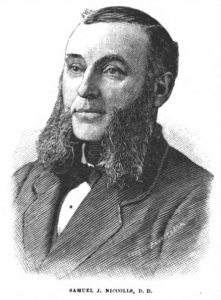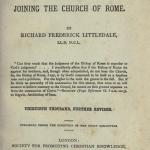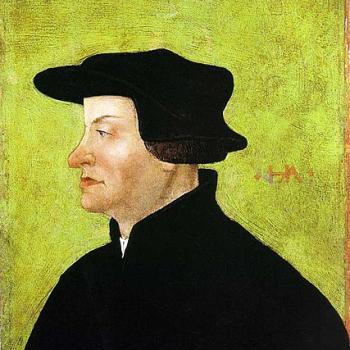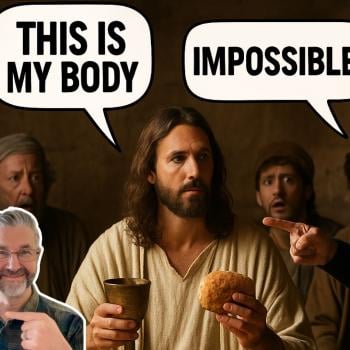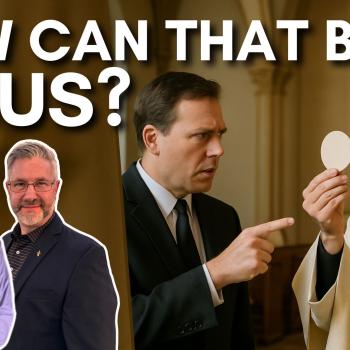“Please Hit ‘Subscribe’”! If you have received benefit from this or any of my other 4,600+ articles, please follow this blog by signing up (with your email address) on the sidebar to the right (you may have to scroll down a bit), above where there is an icon bar, “Sign Me Up!”: to receive notice when I post a new blog article. This is the equivalent of subscribing to a YouTube channel. Please also consider following me on Twitter / X and purchasing one or more of my 55 books. All of this helps me get more exposure, and (however little!) more income for my full-time apologetics work. Thanks so much and happy reading!
***
I am critiquing Lecture XII (pp. 299-320) in the book, Errors and Persecutions of the Roman Catholic Church, published in 1881 by J. H. Chambers & Co. (St. Louis), which is entitled, “The Charge of Idolatrous Worship made against the Roman Church: Is it True?” It was written by a Presbyterian: Rev. Samuel J. Niccolls, D.D. (1838-1915). He was a chaplain during the Civil War, a pastor, and moderator at the 1872 meeting of the General Assembly of the Presbyterian Church in Detroit. The organization of the Young Men’s Christian Association (YMCA) owes its success largely to his influence and perseverance. Dr. Niccolls was selected to receive special honors by Princeton University in its Sesquicentennial Celebration in 1896. His words will be in blue.
***
Protestants, ever since the time of the Reformation, have asserted that the worship of the church of Rome is idolatrous in its nature and tendencies. This charge constitutes one of the chief reasons of their opposition to that church. They claim that the usages of worship which prevail in it, are not only contrary to the practice of the primitive church, but that they are in direct contradiction to the positive commands of the Word of God.
On the other hand, the adherents of the church of Rome have most strenuously denied this charge as slanderous in the extreme; they have complained that they have been misrepresented in this matter, and that their true belief is the very reverse of what has been charged against them. . . .
If it is not true, one party is a slanderer of the church of God, and a chief reason for its existence turns out to be a lie.
Very true!
If it is true, the other against whom the accusation is made, is branded with guilt and dishonor.
Yes, if true. The key word is if.
It is proposed to set the facts of this controversy plainly and fairly before the intelligent reader, that he may judge for himself.
Fair enough! Let’s see what he can come up with.
First of all, in order to reach a right decision, it is necessary to know what constitutes idolatry. Both Protestants and Romanists are agreed that it is a most heinous sin; that the word of God condemns it; and that idolatrous worship is hateful in the sight of God. But what is idolatry? What are the characteristics of an idolatrous worship? These questions are to be answered by the Scriptures, and by them alone.
The Bible is what we both revere as God’s inspired revelation, so it’s where the “battle” must be fought.
The internal act of worship consists in giving to God the supreme reverence, love and confidence of our hearts. Whatever usurps His place in the soul of man, is an idol, a false god; . . .
The external act of idolatry consists in worshipping false gods, or in giving to other objects than God that homage and worship which are due to Him alone. Any form of worship which robs God of the supreme homage due Him, by ascribing divine attributes and offices to creatures; or which sets before the worshipper as the object of his trust and adoration, a being who is not God, is plainly idolatrous. It is a violation of the first commandment.
We agree.
But it is also taught in the Scriptures that God must not be worshipped by the use of images or pictures.
This is where we start to disagree.
The second commandment clearly forbids this, and stamps such worship as idolatrous. The precise thing forbidden by it, is the making of images or pictures as objects of worship, and bowing down to them and serving them, that is, performing acts of religious worship before them.
Revelation 9:20 (RSV) The rest of mankind, who were not killed by these plagues, did not repent of the works of their hands nor give up worshiping demons and idols of gold and silver and bronze and stone and wood, which cannot either see or hear or walk;
This does not absolutely preclude, however, the notion of worshiping the true God with the help of a visual aid, as I will show in due course. Idolatry is a matter of disobedience in the heart towards the one true God. We don’t always need an image to have an idol. Most idols today are non-visual: money, lust for power, convenience, our own pride or intellects; there are all sorts of idols. Anything that replaces God as the most important thing in our life and the universe, is an idol.
The Hebrew word translated ”serve” includes all kinds of external homage, such as burning incense, making offerings, and kissing in token of subjection.
I’ll take his word for that, but the point is to what or to Whom these acts are directed. This still doesn’t absolutely preclude all images and religious objects, properly used.
. . . terrible judgments . . . fell upon the people whenever they attempted to worship God by images. When in the wilderness the people demanded of Aaron that he should introduce image- worship among them, their purpose was not to renounce Jehovah as their God; they only asked a symbol of Him, as the heathen had their symbols.
I don’t think the text teaches this at all. They weren’t trying to worship the true God via an image. Aaron and the mob were after something entirely different:
Exodus 32:1, 4, 7-8 When the people saw that Moses delayed to come down from the mountain, the people gathered themselves together to Aaron, and said to him, “Up, make us gods, who shall go before us; . . .” [4] And he received the gold at their hand, and fashioned it with a graving tool, and made a molten calf; and they said, “These are your gods, O Israel, who brought you up out of the land of Egypt! . . .” [7] And the LORD said to Moses, “Go down; for your people, whom you brought up out of the land of Egypt, have corrupted themselves; [8] they have turned aside quickly out of the way which I commanded them; they have made for themselves a molten calf, and have worshiped it and sacrificed to it . . .”
That’s not only rank idolatry and blasphemy, but polytheism as well. Dr. Niccolls completely misrepresents the nature of what was going on there. God said that He would “blot out of” His “book” (Ex 32:33) whoever engaged in this idolatry, and He “sent a plague” to judge them (Ex 33:35. This was not just using an image improperly in worship; it was much more serious: pretending that a golden calf was actually a “god” who had brought them out of Egypt. Dr. Niccolls vainly tries to force-fit this into a scenario that would include all religious images, and it just doesn’t fly.
. . . one essential mark of the true worship of Jehovah, as contrasted with idolatrous worship, was that in it no images or visible objects representing the invisible object of worship were to be used. The Jews from the time of Moses until now, have always considered the worship of the true God by images as much an act of idolatry as the worship of false gods . . . Indeed, the scriptures make little or no difference between the worshipping of God by images, and the worshipping of false gods. Both are idolatrous.
This simply isn’t true. Moses had worshiped God in the burning bush on Mt. Sinai (Ex 3:2-6). It was not only fire, but also called an “angel of the Lord” (Ex 3:2), yet also “God” (3:4, 6, 11, 13-16, 18; 4:5, 7-8) and “the LORD” (3:7, 16, 18; 4:2, 4-6, 10-11, 14) interchangeably. The wandering Hebrews worshiped Him in the pillars of fire and cloud: all images of God, by God’s own design. One of the most striking and undeniable passages about such worship-of God-through-an-image appears in the very next chapter:
Exodus 33:10 And when all the people saw the pillar of cloud standing at the door of the tent, all the people would rise up and worship, every man at his tent door.
Note that the pillar of cloud is:
1) a creation (water, if a literal cloud);
2) visual, hence an image;
and
3) thought to directly represent God Himself.
It’s also a supernatural manifestation, which is a major difference compared to any true idol made by the hands of men; but that would make no difference for those who mistakenly hold that any image whatsoever associated with God is impermissible. The Bible mentions a pillar of cloud and also a pillar of fire (by night), representing God (see: Ex 13:21-22; 14:24; Num 14:14; Neh 9:12, 19). The Bible specifically makes it clear that God was “in” the two pillars:
Exodus 13:21 And the LORD went before them by day in a pillar of cloud . . . and by night in a pillar of fire . . .
Exodus 14:24 . . . the LORD in the pillar of fire and of cloud looked down upon the host of the Egyptians . . .
Exodus 33:9 When Moses entered the tent, the pillar of cloud would descend and stand at the door of the tent, and the LORD would speak with Moses.
Numbers 12:5 And the LORD came down in a pillar of cloud, and stood at the door of the tent . . .
Numbers 14:14 . . . thou, O LORD, art in the midst of this people; for thou, O LORD, art seen face to face, and thy cloud stands over them and thou goest before them, in a pillar of cloud by day and in a pillar of fire by night.
Deuteronomy 31:15 And the LORD appeared in the tent in a pillar of cloud . . .
Psalm 99:7 He spoke to them in the pillar of cloud;
This represented God, and His people worshiped Him in the cloud, which we know with certainty from Exodus 33:10. It doesn’t always state that the people worshiped God through the supernatural image-pillars, but we know from Exodus 33:8-10 that it was entirely permissible to do so (no hint of condemnation in the biblical text); certainly not “idolatry.” Moreover, the Jews “worshiped” God as represented by fire — or God in the fire — in an additional way:
2 Chronicles 7:1-4 When Solomon had ended his prayer, fire came down from heaven and consumed the burnt offering and the sacrifices, and the glory of the LORD filled the temple. [2] And the priests could not enter the house of the LORD, because the glory of the LORD filled the LORD’s house. [3] When all the children of Israel saw the fire come down and the glory of the LORD upon the temple, they bowed down with their faces to the earth on the pavement, and worshiped and gave thanks to the LORD, saying, “For he is good, for his steadfast love endures for ever.” [4] Then the king and all the people offered sacrifice before the LORD.
God Himself expressly sanctions such images (cloud and fire), and worship in conjunction with them. Therefore, not all images of God are idolatrous. Case closed. Game, set, match . . .
God made Himself specially present in or near material objects, too. He states repeatedly that He is present above the “mercy seat” on the ark of the covenant, between the two carved cherubim (Ex 25:22; 30:6; Lev 16:2; Num 7:89; 1 Sam 4:4; 2 Sam 6:2; 2 Kg 19:15; 1 Chr 13:6; Ps 80:1; 99:1; Is 37:16; Ezek 10:4; Heb 9:5). Therefore, we are informed that the Jews would bow before the ark to pray or worship:
Joshua 7:6 Then Joshua rent his clothes, and fell to the earth upon his face before the ark of the LORD until the evening . . . [proceeds to pray in 7:7-8]
1 Chronicles 16:4 Moreover he appointed certain of the Levites as ministers before the ark of the LORD, to invoke, to thank, and to praise the LORD, the God of Israel.
We agree. We completely disagree that anything in our teaching espouses this. We don’t teach that any saint isn’t a creature, or is omniscient or omnipotent or omnipresent, or immutable, or answers prayers on their own without God, etc. It’s a lie; a bum rap. And where do these people get off making these claims; thinking that they don’t have to document them from our own theology and our official “books”?
James 5:17-18 Elijah was a man of like nature with ourselves and he prayed fervently that it might not rain, and for three years and six months it did not rain on the earth. [18] Then he prayed again and the heaven gave rain, and the earth brought forth its fruit.
Would it not follow, then, that Elijah seemed to have a particular influence over weather? Therefore, why couldn’t someone ask him to pray to God about the weather, rather than someone else, since he had this record of asking for rain to cease, and it did for three and-a-half years? So he became, in effect, the “patron saint of meteorological petitions.” We do roughly the same in this life with friends, on the level of empathy. So, for example, if a woman has difficulty with miscarriage or difficult pregnancies or deliveries, she might go to a woman who has experienced the same thing and ask her to pray to God for her.
I don’t see any intrinsic difficulty here. Catholics don’t ever deny anyone the ability to “go straight to God.” But we assert with James that certain prayers of certain people have more power (also with regard to certain specificities); therefore it is sensible to go to them as intermediaries. And this includes those in heaven, of whom Jesus said that they were more alive than we are. The Bible massively teaches that we can and should go to the most holy person we know and ask them to pray to God for us or for some cause. So once again, we are being more biblical than our Protestant critics.
Thus the saints are asked to give that which God alone can bestow,
We don’t ask them to bestow the answer, but rather, to ask God to do so; to intercede.
and as they are addressed by their worshippers from every part of the earth,
We don’t worship them.
and by many thousands at the same hour, the mind of the worshipper must clothe them with the attributes of omniscience and omnipresence.
This doesn’t follow, either. See:
I believe… he [Jesus Christ] was born of the blessed Virgin, who, as well after as she brought him forth, continued a pure and unspotted virgin. (“Letter to a Roman Catholic,” quoted in A. C. Coulter, John Wesley, New York: Oxford University Press, 1964, 495)
*
*
*
*
*
*
Practical Matters: Perhaps some of my 4,600+ free online articles (the most comprehensive “one-stop” Catholic apologetics site) or fifty-five books have helped you (by God’s grace) to decide to become Catholic or to return to the Church, or better understand some doctrines and why we believe them.
Or you may believe my work is worthy to support for the purpose of apologetics and evangelism in general. If so, please seriously consider a much-needed financial contribution. I’m always in need of more funds: especially monthly support. “The laborer is worthy of his wages” (1 Tim 5:18, NKJV). 1 December 2021 was my 20th anniversary as a full-time Catholic apologist, and February 2022 marked the 25th anniversary of my blog.
PayPal donations are the easiest: just send to my email address: [email protected]. Here’s also a second page to get to PayPal. You’ll see the term “Catholic Used Book Service”, which is my old side-business. To learn about the different methods of contributing (including Zelle), see my page: About Catholic Apologist Dave Armstrong / Donation Information. Thanks a million from the bottom of my heart!
*
***
Photo credit: sketch of Samuel J. Nichols. Source: Alfred Nevin, David Robert Bruce Nevin, editors, Encyclopaedia of the Presbyterian Church in the United States of America (Philadelphia: Presbyterian Encyclopaedia Publishing Co., 1884), 576. [Find a Grave website]
Summary: I respond to the anti-Catholic arguments of the Presbyterian Rev. Samuel J. Niccolls, D.D. (1838-1915), concerning alleged idolatrous worship & piety in Catholicism.


